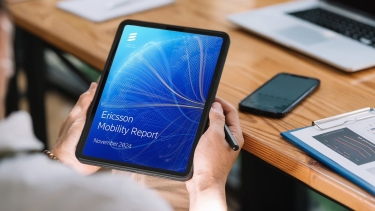According to the November 2024 edition of the Ericsson Mobility Report, at the end of 2024, the GCC countries are set to have 47% 5G subscription penetration, driven by sectors such as tourism, technology, and renewable energy..
The report, which extends the forecast period until the end of 2030, also addresses how AI could impact uplink and downlink network traffic, driving potential mobile traffic growth beyond current baseline predictions.
According to the report, 5G Standalone (5G SA) and 5G Advanced are expected to be a key focus for communications service providers (CSPs) for the remainder of the decade as they deploy new capabilities to create offerings centred on value delivery rather than data volume.
While the rate of mobile network traffic data growth is declining - estimated at 21% year-on year for 2024 - it is still expected to grow almost three-fold by the end of 2030 from present day numbers.
Globally, 5G networks are expected to carry about 80% of total mobile data traffic by the end of 2030 - compared to 34% by the end of 2024.
It is projected that the GCC will have the highest 5G penetration in 2030 at 93%, followed closely by Western Europe at 92% and North America at 91%.
|
|
The report identifies a key trend in the telecoms industry as the transformation of service providers from traditional telcos to technology companies, with the transition fuelled by the rollout of 5G.
According to the report, the 5G rollout has enabled the introduction of advanced services, including AI and the cloud solutions and services, factory automation and content delivery where network slicing will be critical in delivering these services.
"High-performance networks, application programming interfaces (APIs) and a vibrant developer community are expected to drive growth," the report states.
Nicolas Blixell, Vice President and Head of Gulf Cooperation Council Countries at Ericsson Middle East and Africa, said the November 2024 Ericsson Mobility Report highlights the pivotal role of 5G Standalone and 5G Advanced in the future of mobile networks, particularly in regions like the GCC, where high mobile penetration and rapid urbanisation are driving demand for advanced connectivity.
"These technologies are set to enable capabilities such as programmable networks and AI connectivity driven use cases, creating new opportunities for growth and innovation," Blixell said.
"As service providers in the GCC and beyond adopt these advancements, they will unlock the full potential of 5G, driving digital transformation and enhancing the way industries and consumers engage with technology.”
Of about 320 CSPs currently offering commercial 5G services globally, less than 20% are 5G Standalone (SA), but this is expected to grow to almost 60% by the end of 2030.
According to the report, Fixed Wireless Access (FWA) also continues to grow in popularity globally as the second largest 5G use case after enhanced Mobile Broadband (eMBB).
The report also addresses how AI, including Generative AI Applications - already integrated across smartphones, laptops, watches and FWA products - could impact uplink and downlink network traffic, driving potential mobile traffic growth beyond current baseline predictions.
The first 6G deployments are expected in 2030, building on and scaling the capabilities of 5G SA and 5G Advanced.
The November 2024 Ericsson Mobility Report can be accessed through this link.








































